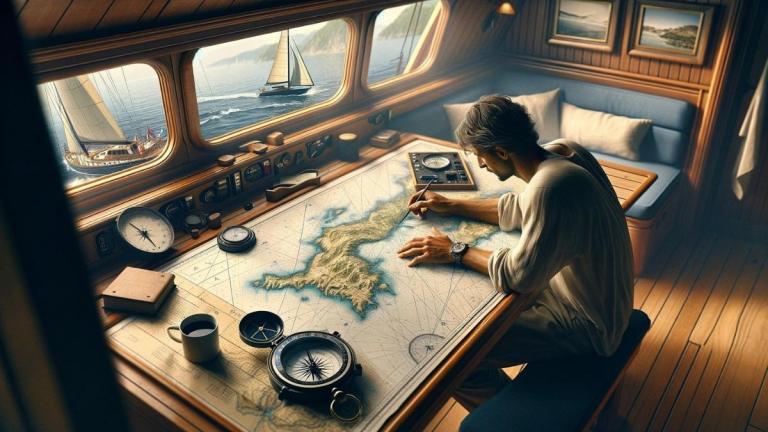Sailing: From Beginner to Expert
Traveling by sailboat is like opening the door to the endless blue of the sea. Even standing on the threshold of this door is the halfway of having this experience and new knowledge.
This journey begins with learning the language of the sea, feeling the song of the wind and adapting to the rhythm of the water. For a beginner sailor, it is vital to learn the basics of nautical knowledge. You need to understand safety procedures and develop basic maneuvering skills. These are the first steps in embracing sailing not only as a sport or hobby, but also as a way of life.
As the voyage goes on, sailors grow closer to the sea and wind. They learn a lot about sailing, including how to adjust sails, navigate, forecast the weather, and plan long-distance trips. In the process, each new voyage broadens your experience. Each new voyage also provides the opportunity to learn practical skills such as sailboat maintenance and repair.
As you move from beginner to expert, you’ll handle sea challenges better and fully enjoy the freedom and calm of the ocean. This journey transforms sailing from a mere activity into a passion and opens the door to free sailing on endless seas.

Sailing Boat Basics and Requirements
Traveling by sailboat is a unique way to feel the nature and freedom. Before starting this adventure, it’s important to learn the basics of sailing and what you need for a safe and fun experience.
First of all, choosing a suitable sailing boat is of paramount importance. Consider the size, type, and equipment of the boat based on the length and conditions of your planned trips.
Also, ensure your sailing gear and safety equipment are complete and in good shape to handle any sea challenges. Basic equipment includes items such as adequate spare parts, repair kits, life jackets and communication tools.
Successful Sailing: Theory to Practice
Learning the basics of sailing and putting this knowledge into practice forms the basis of a successful sailing experience. You can acquire theoretical knowledge about sailing through maritime courses or training from experienced sailors. These trainings provide knowledge on topics such as safety at sea, basic navigation, weather reading and sail settings.
However, in addition to theoretical knowledge, it is of great importance to reinforce this knowledge practically on the water. Traveling by sailboat is an adventure full of lasting moments. Also travelling with sailboat ensure opportunities for a sailor equipped with the right knowledge and skills. Therefore, basic sailing knowledge and requirements are the first step in this special relationship with the sea.
Sailing Boat Usage and Safety Precautions
Safety precautions when sailing are vital to minimize risks at sea and to be prepared for possible emergencies. On every sailing trip, make sure there are enough properly sized and approved lifejackets for everyone on board. Also, keep rescue equipment like signal lights and alarms easily accessible and ready to use.
Make sure to have safety equipment like fire extinguishers, first aid kits, and emergency stop devices on board. Also, use tech tools like navigation gear, weather monitors, and communication devices to help you stay safe while sailing. Training the crew in emergency procedures and practicing safety drills are essential for quick and effective responses in emergencies. These safety precautions are the cornerstones of enjoying sailing safely.

Voyage Planning and Route Determination with Sailing
Planning and routing a sailing trip is the foundation of a successful sailing adventure. This process starts with clarifying your goals, determining the duration of your voyage and your destinations. When planning, check the weather forecasts, sea currents, and seasonal conditions to pick the best time for a safe and enjoyable cruise.
Also, consider key points along your route, like ports, marinas, and emergency stops, to prepare for any needs. Choose routes that match your experience level and your crew’s abilities to ensure a safe and enjoyable voyage.
When planning your voyage, you should also consider the capacity and features of your sailboat. These factors are crucial for planning. Your boat must carry basics like fuel, water, and food, as well as extra equipment and spare parts for longer trips.
When picking a route, make detailed safety and emergency plans to be ready for any surprises. These preparations boost your knowledge and gear, giving you peace of mind and confidence for a better sailing experience.
With good planning and preparation, a sailing trip becomes a memorable adventure.
Common problems that can occur with sailing boats
Common malfunctions in sailboat are usually:
- Engine problems,
- Damage to sail and spinnaker rigging,
- Mast and boom problems,
- Electrical system failures and leaks.
Engine problems may cause by improper fuel use, inadequate maintenance or failures in the cooling system.
Harsh weather conditions and material fatigue may cause tearing or abrasion of sails and spinnakers. Damaging the mast and boom is often the result of improper maneuvers or accidents. Electrical system failures are short circuits and power losses. Old or frayed cables and connection points may cause these kind of problems.
Hhull damage, weaknesses in connection points or external influences may cause hull leakes. Regular maintenance and inspections can help prevent problems, but sailors should always be ready for unexpected situations at sea.
What requirements are necessary to become an experienced sailor
Becoming a master sailor requires more than just technical skills. It requires a deep passion for the sea, patience and a desire to learn continuously. Nautical knowledge and mastery of sailing techniques develops through experience in a wide range of conditions.
Master sailors have a thorough knowledge of navigation. They have forecasting, ship handling and emergency management. They are also skilled in the maintenance and repair of their boats.
Master sailors can solve challenges quickly and effectively. A good sailor is someone who can work in harmony with their crew. Master sailors have leadership skills and they can be both logical and intuitive in their decision-making.
You acquire this high level of skill and knowledge over time through practical experience and continuous training. To become a master sailor, you need to handle sea challenges well and fully enjoy its freedom.





